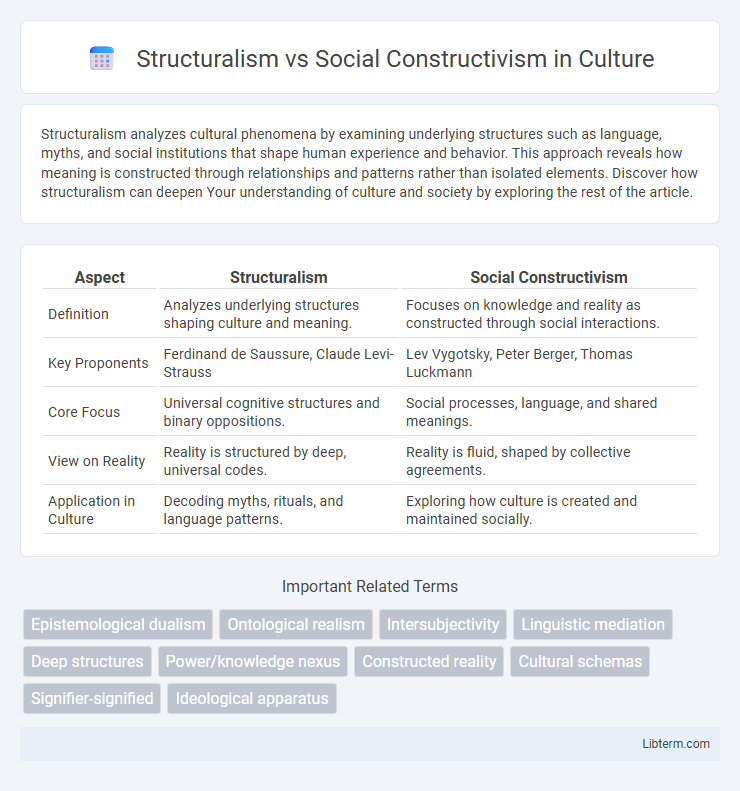Structuralism analyzes cultural phenomena by examining underlying structures such as language, myths, and social institutions that shape human experience and behavior. This approach reveals how meaning is constructed through relationships and patterns rather than isolated elements. Discover how structuralism can deepen Your understanding of culture and society by exploring the rest of the article.
Table of Comparison
| Aspect | Structuralism | Social Constructivism |
|---|---|---|
| Definition | Analyzes underlying structures shaping culture and meaning. | Focuses on knowledge and reality as constructed through social interactions. |
| Key Proponents | Ferdinand de Saussure, Claude Levi-Strauss | Lev Vygotsky, Peter Berger, Thomas Luckmann |
| Core Focus | Universal cognitive structures and binary oppositions. | Social processes, language, and shared meanings. |
| View on Reality | Reality is structured by deep, universal codes. | Reality is fluid, shaped by collective agreements. |
| Application in Culture | Decoding myths, rituals, and language patterns. | Exploring how culture is created and maintained socially. |
Introduction to Structuralism and Social Constructivism
Structuralism analyzes human culture and cognition through underlying structures such as language, myths, and social norms, emphasizing universal patterns and relationships. Social Constructivism views knowledge and meaning as co-created through social interactions, highlighting the influence of cultural and historical contexts on individual understanding. Both frameworks explore how reality and knowledge are shaped but differ in their focus on fixed structures versus dynamic social processes.
Historical Background of Both Paradigms
Structuralism emerged in the early 20th century, heavily influenced by Ferdinand de Saussure's work on linguistics and Claude Levi-Strauss's studies in anthropology, emphasizing underlying structures that shape culture and human experience. Social Constructivism developed later, rooted in the mid-20th century, drawing from sociologists like Peter Berger and Thomas Luckmann, highlighting the role of social interactions and shared meanings in constructing reality. Both paradigms contrast in historical context, with structuralism focusing on universal systems and social constructivism on dynamic, socially negotiated knowledge.
Core Principles of Structuralism
Structuralism centers on uncovering the underlying structures that govern human thought, language, and culture, emphasizing relationships between elements within a system. It views meaning as arising from the interdependence of binary oppositions and consistent patterns that shape perception and behavior. Key figures such as Ferdinand de Saussure and Claude Levi-Strauss highlight that these deep structures operate unconsciously, influencing how individuals interpret the world.
Fundamental Concepts of Social Constructivism
Social Constructivism centers on the idea that knowledge and meaning are generated through social interactions and shared experiences rather than existing independently. Fundamental concepts include the mediation of knowledge through cultural tools and language, the active role of learners in constructing understanding, and the contextual nature of learning influenced by social, historical, and cultural factors. This theory contrasts with Structuralism by emphasizing dynamic social processes over fixed structural elements.
Key Thinkers and Their Contributions
Structuralism, pioneered by Claude Levi-Strauss, emphasizes underlying structures in human culture and cognition, revealing universal patterns in myths and language. Social Constructivism, shaped by Lev Vygotsky, highlights the role of social interactions and cultural contexts in knowledge formation, stressing the importance of language and collaboration. Both frameworks significantly influence contemporary sociology and anthropology by dissecting how meaning and reality are constructed either through inherent structures or social processes.
Structuralism: Understanding Social Structures
Structuralism analyzes social structures as underlying systems that shape human behavior and cultural phenomena through stable, often unconscious patterns and relationships. It emphasizes the role of deep, enduring frameworks such as language, kinship, and myth that govern social organization and meaning-making processes. Key figures like Claude Levi-Strauss argue that these structures exist independently of individual actions, providing a blueprint for interpreting social realities.
Social Constructivism: Emphasis on Human Interaction
Social Constructivism emphasizes human interaction as the foundation for knowledge construction, asserting that understanding emerges through collaborative dialogue and social engagement. Unlike Structuralism, which focuses on underlying cognitive structures, Social Constructivism highlights the dynamic, context-dependent processes by which individuals co-create meanings within cultural and social frameworks. This approach prioritizes the role of language, communication, and shared experiences in shaping human cognition and learning.
Major Differences and Points of Divergence
Structuralism emphasizes underlying structures that shape human experience, such as language systems and cognitive frameworks, while social constructivism centers on the ways social interactions and cultural contexts create shared meanings. Structuralism prioritizes objective, often universal patterns in human thought, whereas social constructivism highlights subjective, dynamic processes influenced by historical and societal factors. The key divergence lies in structuralism's search for deep, stable structures versus social constructivism's focus on fluid, context-dependent knowledge construction.
Applications in Contemporary Social Sciences
Structuralism in contemporary social sciences analyzes underlying systems such as language, culture, and society to uncover universal patterns and relationships, aiding in fields like linguistics, anthropology, and psychology. Social constructivism emphasizes the role of social interactions and shared meanings in shaping knowledge and reality, influencing educational practices, identity studies, and organizational behavior. Both frameworks provide complementary insights, where structuralism reveals deep-seated structures while social constructivism highlights dynamic processes of meaning-making within social contexts.
Conclusion: Implications and Future Directions
Structuralism emphasizes the fixed, underlying frameworks shaping human cognition and society, while social constructivism highlights the dynamic, context-dependent nature of meaning created through social interactions. Future research should integrate these perspectives to explore how cognitive structures and social processes co-evolve, advancing interdisciplinary approaches in psychology, anthropology, and education. Understanding this interplay informs innovative strategies for knowledge production, cultural analysis, and learning methodologies in diverse social contexts.
Structuralism Infographic

 libterm.com
libterm.com